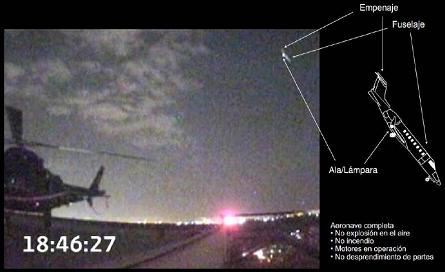Mexican investigators have disclosed that the Bombardier Learjet 45 which crashed in Mexico City this month, killing 14 people, closed to within the minimum in-trail separation distance from a Mexicana Boeing 767-300 just before the accident.
Despite the pilots' being instructed to reduce speed, to maintain separation in the landing sequence to Mexico City, the Learjet continued to drift towards the preceding 767, and the pilots were suddenly forced to battle turbulence. The executive jet failed to recover from the in-flight upset and crashed into a busy section of the capital city.
Images from a ground surveillance camera, released by the Mexican transport ministry, clearly show the 767's lights as it flies overhead and turns to make its final approach to the airport. Shortly afterwards it briefly captures the Learjet diving towards the ground, at a nose-down pitch of 42°-46°, and the explosion on impact.
Source: Mexican transport ministry |
|
|
|---|
Source: Mexican transport ministry |
Along with the three crew and six passengers - among them the Mexican interior minister - five people on the ground also died in the 4 November accident.
The ministry has given preliminary, but extensive, factual data showing that the Learjet was sequenced to land behind Mexicana flight MX1692, a 767-300 arriving from Buenos Aires, and ahead of a Click Fokker 100 operating as QA7225.
At the time the aircraft were sequenced the Learjet was 6nm (11km) behind the 767. Mexico City approach controllers, just after 18:44, instructed the Learjet - whose ground speed was much higher than the 767's - to reduce speed to 180kt.
Radar data, says the ministry, shows that the Learjet did not begin to slow "significantly" until 1min 12s later, as it approached the 767. While the required minimum separation between the 767 and the Learjet was 5nm, the two were only 4.15nm apart about 15s before the Learjet began its fatal descent.
Transcripts of the Learjet pilots' conversation at the time show they were battling to control the aircraft after encountering turbulence.
"We know that the crew acknowledged the presence of turbulence, triggered by the wake of the aircraft, and...immediately after this recognition of wake turbulence the aircraft...began its descent...at a very pronounced angle, culminating in its impact with the ground," says Mexican transport secretary Luis Tellez.
There is no evidence, he adds, of any technical malfunction or other abnormality preceding the accident sequence.
Investigators are to perform tests using simulators to assess the potential effect of wake turbulence from a 767 in order to confirm whether it contributed to the loss of the aircraft.
Source: Air Transport Intelligence news




















